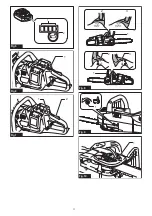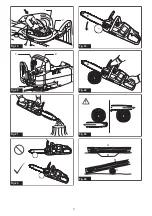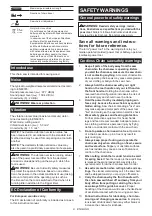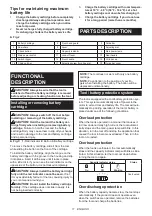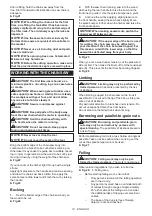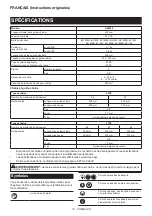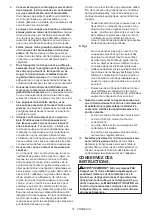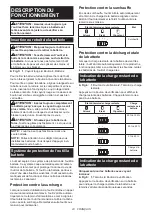
10 ENGLISH
11.
Keep handles dry, clean, and free from oil and
grease.
Greasy, oily handles are slippery causing
loss of control.
12.
Cut wood only. Do not use chain saw for pur-
poses not intended.
For example: do not use
chain saw for cutting plastic, masonry or non-
wood building materials. Use of the chain saw for
operations different than intended could result in a
hazardous situation.
13.
Causes and operator prevention of kickback:
Kickback may occur when the nose or tip of the
guide bar touches an object, or when the wood
closes in and pinches the saw chain in the cut.
Tip contact in some cases may cause a sudden
reverse reaction, kicking the guide bar up and
back towards the operator. Pinching the saw chain
along the top of the guide bar may push the guide
bar rapidly back towards the operator. Either of
these reactions may cause you to lose control of
the saw which could result in serious personal
injury. Do not rely exclusively upon the safety
devices built into your saw. As a chain saw user,
you should take several steps to keep your cutting
jobs free from accident or injury.
Kickback is the result of tool misuse and/or incor-
rect operating procedures or conditions and can be
avoided by taking proper precautions as given below:
•
Maintain a firm grip, with thumbs and fingers
encircling the chain saw handles, with both
hands on the saw and position your body
and arm to allow you to resist kickback
forces. Kickback forces can be controlled by
the operator, if proper precautions are taken.
Do not let go of the chain saw.
►
Fig.1
•
Do not overreach and do not cut above
shoulder height. This helps prevent unin-
tended tip contact and enables better control
of the chain saw in unexpected situations.
•
Only use replacement bars and chains spec
-
ified by the manufacturer. Incorrect replace
-
ment bars and chains may cause chain
breakage and/or kickback.
•
Follow the manufacturer’s sharpening and
maintenance instructions for the saw chain.
Decreasing the depth gauge height can lead
to increased kickback.
14.
Before starting work, check that the chain
saw is in proper working order and that its
condition complies with the safety regulations.
Check in particular that:
•
The chain brake is working properly;
•
The run-down brake is working properly;
•
The bar and the sprocket cover are fitted
correctly;
•
The chain has been sharpened and ten
-
sioned in accordance with the regulations.
15.
Do not start the chain saw with the chain cover
being installed on it.
Starting the chain saw with
the chain cover being installed on it may cause
the chain cover to thrown out forward resulting in
personal injury and damage to objects around the
operator.
SAVE THESE INSTRUCTIONS.
WARNING:
DO NOT let comfort or familiarity
with product (gained from repeated use) replace
strict adherence to safety rules for the subject
product. MISUSE or failure to follow the safety
rules stated in this instruction manual may cause
serious personal injury.
Important safety instructions for
battery cartridge
1.
Before using battery cartridge, read all instruc-
tions and cautionary markings on (1) battery
charger, (2) battery, and (3) product using battery.
2.
Do not disassemble battery cartridge.
3.
If operating time has become excessively
shorter, stop operating immediately. It may
result in a risk of overheating, possible burns
and even an explosion.
4.
If electrolyte gets into your eyes, rinse them
out with clear water and seek medical atten-
tion right away. It may result in loss of your
eyesight.
5.
Do not short the battery cartridge:
(1)
Do not touch the terminals with any con-
ductive material.
(2)
Avoid storing battery cartridge in a con-
tainer with other metal objects such as
nails, coins, etc.
(3)
Do not expose battery cartridge to water
or rain.
A battery short can cause a large current
flow, overheating, possible burns and even a
breakdown.
6.
Do not store the tool and battery cartridge in
locations where the temperature may reach or
exceed 50 °C (122 °F).
7.
Do not incinerate the battery cartridge even if
it is severely damaged or is completely worn
out. The battery cartridge can explode in a fire.
8.
Be careful not to drop or strike battery.
9.
Do not use a damaged battery.
10.
The contained lithium-ion batteries are subject to
the Dangerous Goods Legislation requirements.
For commercial transports e.g. by third parties,
forwarding agents, special requirement on pack-
aging and labeling must be observed.
For preparation of the item being shipped, consult-
ing an expert for hazardous material is required.
Please also observe possibly more detailed
national regulations.
Tape or mask off open contacts and pack up the
battery in such a manner that it cannot move
around in the packaging.
11.
Follow your local regulations relating to dis-
posal of battery.
SAVE THESE INSTRUCTIONS.
CAUTION:
Only use genuine Makita/Dolmar
batteries.
Use of non-genuine Makita/Dolmar batter-
ies, or batteries that have been altered, may result in
the battery bursting causing fires, personal injury and
damage. It will also void the Makita/Dolmar warranty
for the Makita/Dolmar tool and charger.
Summary of Contents for AS3835
Page 2: ...Fig 1 2 1 17 3 4 5 6 11 13 15 12 18 7 8 10 16 9 14 Fig 2 1 2 3 Fig 3 1 2 Fig 4 2 ...
Page 3: ...1 2 Fig 5 1 Fig 6 2 1 Fig 7 2 3 1 2 3 1 Fig 8 1 Fig 9 1 Fig 10 3 ...
Page 4: ...1 Fig 11 1 2 Fig 12 1 Fig 13 1 Fig 14 2 1 3 Fig 15 2 1 Fig 16 1 2 Fig 17 2 3 1 Fig 18 4 ...
Page 5: ...2 1 Fig 19 1 2 Fig 20 Fig 21 Fig 22 Fig 23 Fig 24 Fig 25 A B A B Fig 26 5 ...
Page 7: ...1 2 Fig 35 30 1 5 1 Fig 36 Fig 37 Fig 38 Fig 39 2 1 Fig 40 1 2 Fig 41 1 2 Fig 42 7 ...



